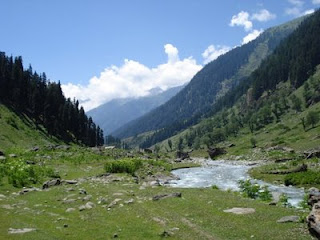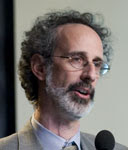-
Weekly Reading
›“A New Military Mission: Clean Energy,” part of the Center for American Progress’ “It’s Easy Being Green” series, highlights the military’s attempts to become more energy-efficient. Read more about the U.S. military’s environmental initiatives.
Simon Dalby, a professor at Carleton College, discusses the evolution of environmental security with John Tessitore, executive editor of the Carnegie Council, in a video interview (transcript available).
Climate Change, Food Security, and the Right to Adequate Food examines climate change’s expected impact on food production, with a special focus on Africa and Asia.
The BDA Foundation, a Canadian charity, and PharmAfrica, a pharmaceutical company, are working to create a medicinal plants industry that will lift local people out of poverty in the Democratic Republic of the Congo. -
Video: Malcolm Potts on ‘Sex and War’
›March 6, 2009 // By Wilson Center Staff“What is the thing that may make the world as peaceful as possible?” asks Malcolm Potts in this video from the Environment Change and Security Program. “I think it’s very important to give women as much autonomy in society as we possibly can; to fight as hard as possible for women’s equality. Because these behaviors that created warriors never benefited women.”
In this short expert analysis, Malcolm Potts, Bixby Professor of Population and Family Planning at the University of California Berkeley, discusses his latest book, Sex and War: How Biology Explains Warfare and Terrorism and Offers a Path to a Safer World. To learn more, please see a full summary and complete video of Malcom Potts speaking recently about his book at a February 11, 2009, Wilson Center event.
-
VIDEO: From Report 13 – Christian Leuprecht on Migration as the Demographic Wild Card in Civil Conflict
›March 3, 2009 // By Wilson Center StaffContrary to what many people might think, most migration is within the developing world—“among countries that already face enormous challenges in terms of provisions for their populations, but also ethnic conflict,” says Christian Leuprecht in this short video preview of his article, “Migration as the Demographic Wild Card in Civil Conflict: Mauritius and Fiji,” now appearing in the 13th issue of Environmental Change and Security Program Report.
“So if you have particular ethnic groups, religious groups, or linguistic groups then spilling over borders, there’s a good chance they might destabilize the neighboring country; not just because of carrying capacity and provision of services within that country, but also because it changes the population dynamics and group dynamics within that particular country,” says Leuprecht.
Leuprecht, an assistant professor at the Royal Military College of Canada, and six other demographic experts analyze the links connecting population and environmental dynamics to conflict in a set of commentaries on “New Directions in Demographic Security.” -
Testosterone: The Ultimate Weapon of Mass Destruction?
›March 1, 2009 // By Will Rogers “The ultimate weapon of mass destruction—and perhaps of economic destruction—is the testosterone molecule,” quipped Malcolm Potts at the February 11, 2009, discussion of his new book, “Sex and War: How Biology Explains War and Offers a Path to Peace,” which explores the pivotal question, “Why do human beings systematically and deliberately kill our own species?” Potts, the Bixby Professor of Population and Family Planning at the University of California, Berkeley, was joined Science magazine’s Ann Gibbons, a leading correspondent on human evolution, who examined whether aggressive human behaviors are evolving in response to changing social structures.
“The ultimate weapon of mass destruction—and perhaps of economic destruction—is the testosterone molecule,” quipped Malcolm Potts at the February 11, 2009, discussion of his new book, “Sex and War: How Biology Explains War and Offers a Path to Peace,” which explores the pivotal question, “Why do human beings systematically and deliberately kill our own species?” Potts, the Bixby Professor of Population and Family Planning at the University of California, Berkeley, was joined Science magazine’s Ann Gibbons, a leading correspondent on human evolution, who examined whether aggressive human behaviors are evolving in response to changing social structures.
Testosterone: Risky Business
“In 1987, some anthropologists and sociologists made a statement at UNESCO that it is scientifically incorrect to say we’ve inherited a tendency to make war from our animal ancestors,” said Potts. “I think that that is wrong.” Evolutionary psychology suggests that humans have inherited certain predispositions that “help us adapt to find food, select mates, avoid danger, and compete for resources in a hostile world,” said Potts. Men compete for women, so it is logical, from a reproductive standpoint, that men would take more risks than women, he argued.
In addition, “there’s strong evidence that there is a genetic tendency for men in the prime of life to attack and kill their neighbors,” Potts noted, while emphasizing that this does not mean that men are preordained to fight one another. “Such predispositions are extraordinarily flexible,” and respond well to peaceful cultural norms.
The Pill Is Mightier Than the Sword
“Once we recognize our violent origins, then we need to ask not ‘why do wars break out?’ but ‘why does peace break out?’” posed Potts. “Judged on the basis of same-species killing,” the violent 20th century may have been the most peaceful in human history, he claimed.
“In the whole of recorded history, I cannot find a single example of women banding together spontaneously and then going out to attack a neighboring group,” maintained Potts. He argued that increasing women’s individual freedom and collective power in civil society and government is the best way to achieve a more peaceful world. More specifically, slowing population growth and promoting more balanced age structures by giving women access to family planning will contribute not just to their own autonomy, but also to long-term peace, he argued.
Evolving To Become Less Aggressive?
“Humans are capable of incredible acts of kindness but also despicable acts of terror,” said Gibbons. “We murder, slaughter, barbeque, and even eat our own species, and we’ve been doing it for a long time.” But it is difficult to determine whether this propensity for aggression is an ancient trait or has more recently evolved. “There are no other human species alive to show us different models for male aggression…so we have look at fossils, DNA, and our closest relatives—the chimpanzees and gorillas,” Gibbons said.
Human aggression may be continuing to evolve. As Gibbons explained, “researchers, as they look at the human genome project—the HapMap Project—have discovered there are many, many genes that have come under natural selection that have evolved in the last 100,000 years, since modern humans spread out of Africa.” Therefore, as warfare becomes less necessary to our daily survival, our species might evolve to become less aggressive. “Are we seeing, in our sexual selection, mates being chosen that are a little less aggressive?” Gibbons asked. “We are still evolving,” she emphasized. “The story isn’t over yet.”Photos: From top to bottom, Malcolm Potts and Ann Gibbons. Courtesy of Dave Hawxhurst and the Woodrow Wilson Center.
-
PODCAST – A Discussion on Climate Change and Security: Arctic Links and U.S. Intelligence Community Responses
›February 24, 2009 // By Wilson Center Staff“The climate issue also very clearly illustrates the whole complexity of the security issue,” says Henrik Selin. “Arctic melting is a national security issue in the traditional national security kind of way.” In this podcast from the Environmental Change and Security Program, Selin, assistant professor of international relations at Boston University, and Stacy VanDeveer, associate professor of political science at the University of New Hampshire, sat down with ECSP Director Geoff Dabelko to discuss the resonance of climate change in the U.S. security community.
VanDeveer and Selin were in Washington to speak at a January 12 event, “Governing the Climate: Lessons From the National Conference on Climate Governance.” VanDeveer has frequently coauthored articles with Dabelko, including “It’s Capacity, Stupid: International Assistance and National Implementation” in Global Governance, “European Insecurities: Can’t Live With ’Em, Can’t Shoot ‘Em” in Security Dialogue, and “Environmental Cooperation and Regional Peace: Baltic Politics, Programs, and Prospects” in Environmental Peacemaking. -
In Kashmir, No Refuge for Wildlife
›February 20, 2009 // By Will Rogers “Human-animal conflicts have assumed alarming proportions in the region,” Asghar Inayati, a regional wildlife warden in Kashmir, recently told Inter Press Service (IPS) News. Since India and Pakistan gained independence in 1949, both sides have fought for control of the territory. Not only has the decades-long conflict claimed 100,000 lives (by some estimates), it has also displaced animals from their natural habitats, sparking violent encounters with local people and threatening many species’ survival.
“Human-animal conflicts have assumed alarming proportions in the region,” Asghar Inayati, a regional wildlife warden in Kashmir, recently told Inter Press Service (IPS) News. Since India and Pakistan gained independence in 1949, both sides have fought for control of the territory. Not only has the decades-long conflict claimed 100,000 lives (by some estimates), it has also displaced animals from their natural habitats, sparking violent encounters with local people and threatening many species’ survival. -
Weekly Reading
›An article in Conservation Letters examining the effect of war on wildlife in Cambodia finds that “the legacy of conflict for wildlife can be profound and destructive. To address post-conflict challenges more effectively, conservation must be integrated within broader peacebuilding processes, including disarmament, demobilization, and reintegration of combatants.”
New York Times environmental reporter Andrew Revkin shares a recent nightmare on his blog, Dot Earth: If human beings achieve inexpensive, renewable energy, will this spur environmentally destructive population growth and consumption?
“Today, one-third of the world’s population has to contend with water scarcity, and there are ominous signs that this proportion could quickly increase,” writes the International Water Management Institute’s David Molden in the BBC’s Green Room. “Up to twice as much water will be required to provide enough food to eliminate hunger and feed the additional 2.5 billion people that will soon join our ranks. The demands will be particularly overwhelming as a wealthier, urbanised population demands a richer diet of more meat, fish, and milk.”
“Climate Wars” is a three-part podcast series by the Canadian Broadcasting Corporation.
Circle of Blue has launched the online radio series “5 in 15”; one episode features water expert Peter Gleick, head of the Pacific Institute, while another highlights Mark Turrell, CEO of technology company Imaginatik. -
Pacific Institute’s Peter Gleick Piques Interest With “Peak Water”
›February 12, 2009 // By Rachel Weisshaar Bringing clean water and improved sanitation to the billions who lack them is “not a question of money, it’s not a question of technology, it’s a question of governance, of commitment, will—all of those things. And that, in many ways, is the worst part of the world’s water crisis,” said Peter Gleick, president of the Pacific Institute, at the February 4, 2009, launch of The World’s Water 2008-2009: The Biennial Report on Freshwater Resources. Gleick began by showing No Reason, a short video produced by the Pacific Institute and Circle of Blue for this year’s World Economic Forum in Davos, Switzerland, which examined water issues in several sessions.
Bringing clean water and improved sanitation to the billions who lack them is “not a question of money, it’s not a question of technology, it’s a question of governance, of commitment, will—all of those things. And that, in many ways, is the worst part of the world’s water crisis,” said Peter Gleick, president of the Pacific Institute, at the February 4, 2009, launch of The World’s Water 2008-2009: The Biennial Report on Freshwater Resources. Gleick began by showing No Reason, a short video produced by the Pacific Institute and Circle of Blue for this year’s World Economic Forum in Davos, Switzerland, which examined water issues in several sessions.
What is the Water Crisis?
According to Gleick, the global water crisis comprises many problems, including:- The failure to meet basic human needs for water, which leads to diseases like cholera and typhoid;
- Local water scarcity and resource depletion;
- Contamination by industrial and human wastes;
- The effects of climate change and extreme events;
- Reduced production of food, goods, and services caused by water scarcity, poor water quality, or inequitable water allocation;
- Ecosystem degradation and destruction; and
- Threats to international, national, and subnational security posed by conflict over water.
Because water is a largely renewable resource, we will not completely run out of water. However, Gleick warned that non-renewable water sources such as fossil aquifers are limited. Thus, “peak non-renewable water” could occur if we use fossil groundwater faster than it is recharged; by some estimates, 30-40 percent of today’s global agricultural production comes from non-renewable water, which will become increasingly difficult to extract, said Gleick. “That’s a real challenge from a food point of view, especially in a world that is going from 6.5 billion to 7 billion to 9 billion people.”
Eventually, we will also run up against the ecological and economic flow limits of renewable water sources, which include streams and rivers, Gleick said. And before either non-renewable or renewable peak water, we could reach “peak ecological water,” which occurs when using additional water “causes more ecological damage than it provides human benefit, and the total value of using more water starts to decline,” he explained.
China: Water Challenges Writ Large
China’s stunning economic growth in recent years has come “at an enormous environmental cost…to their air quality, to human health, and especially to water resources,” said Gleick. China’s water is over-allocated, poorly managed, and severely polluted by industrial and human wastes. Desertification in northern China is increasing rapidly, due to deforestation and the excessive withdrawal of groundwater. According to Gleick, some companies have cancelled plans to build plants in China because they cannot obtain sufficient water of high enough quality.
Public protests over environmental degradation in China are becoming increasingly common. According to Gleick, there have been as many as 50,000 protests over environmental issues in a single year, with the majority of these relating to water quality or allocations.
Solutions to the Water Crisis
Gleick recommended a series of actions:- Develop more water sources, while ensuring that environmental and community concerns are addressed;
- Improve water infrastructure, including the installation of low-flow toilets and efficient drip-irrigation systems;
- Improve water-use efficiency;
- Update the Clean Water Act and the Safe Drinking Water Act to include new contaminants, and actively enforce the standards already in place;
- Price water more accurately, with the understanding that water is a human right and should be subsidized for basic human needs;
- Improve and expand public participation in environmental decision-making; and
- Strengthen water institutions and improve communication between them.
For more information, including a webcast of this event, visit ECSP’s website. To receive invitations to future events, e-mail ecsp@wilsoncenter.org.
Showing posts from category conflict.


 “The ultimate weapon of mass destruction—and perhaps of economic destruction—is the testosterone molecule,” quipped Malcolm Potts at the February 11, 2009, discussion of his new book, “
“The ultimate weapon of mass destruction—and perhaps of economic destruction—is the testosterone molecule,” quipped Malcolm Potts at the February 11, 2009, discussion of his new book, “
 “
“ Bringing clean water and improved sanitation to the billions who lack them is “not a question of money, it’s not a question of technology, it’s a question of governance, of commitment, will—all of those things. And that, in many ways, is the worst part of the world’s water crisis,” said Peter Gleick, president of the
Bringing clean water and improved sanitation to the billions who lack them is “not a question of money, it’s not a question of technology, it’s a question of governance, of commitment, will—all of those things. And that, in many ways, is the worst part of the world’s water crisis,” said Peter Gleick, president of the 

